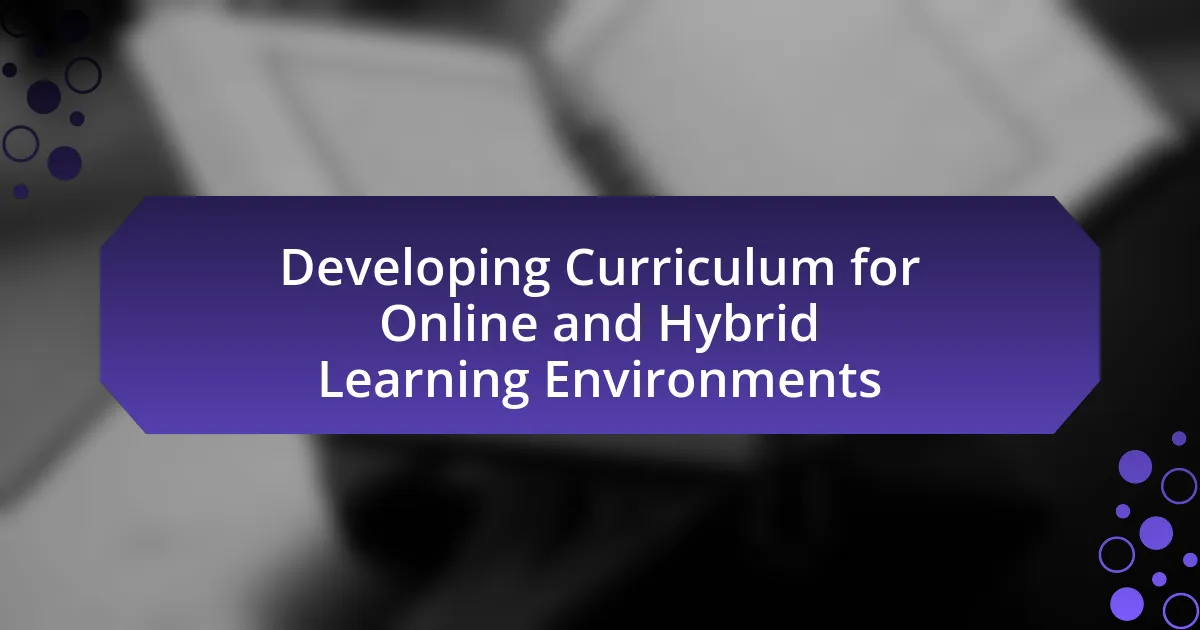Developing curriculum for online and hybrid learning environments involves creating educational programs that effectively utilize digital tools to enhance learning experiences. This process emphasizes technology integration, learner-centered design, and alignment of learning outcomes with assessments, distinguishing it from traditional curriculum design. Key principles include clear learning objectives, engaging content, and interactive assessments, all aimed at improving student engagement and outcomes. The article also addresses challenges such as ensuring engagement and inclusivity, while providing strategies for effective curriculum development, assessment integration, and the use of technology to support diverse learning needs.

What is Developing Curriculum for Online and Hybrid Learning Environments?
Developing curriculum for online and hybrid learning environments involves creating educational programs that effectively integrate digital tools and resources to facilitate learning. This process requires understanding the unique characteristics of online and hybrid formats, such as flexibility, accessibility, and the need for engaging content. Research indicates that well-designed online curricula can enhance student engagement and learning outcomes, as evidenced by studies showing that students in hybrid courses often perform better than those in traditional settings.
How does the development process differ from traditional curriculum design?
The development process for online and hybrid learning environments differs from traditional curriculum design primarily in its emphasis on technology integration and learner-centered approaches. In traditional curriculum design, the focus is often on content delivery through lectures and standardized assessments, whereas the development process for online and hybrid environments prioritizes interactive and flexible learning experiences that leverage digital tools. For instance, research indicates that online learning environments often utilize multimedia resources, collaborative platforms, and adaptive learning technologies to enhance engagement and accommodate diverse learning styles, which contrasts with the more rigid structure of traditional classrooms. This shift reflects a broader trend towards personalized education, supported by studies showing that learner engagement increases when technology is effectively integrated into the curriculum.
What are the key principles of online and hybrid curriculum development?
The key principles of online and hybrid curriculum development include learner-centered design, alignment of learning outcomes with assessments, and the integration of technology to enhance learning experiences. Learner-centered design focuses on the needs, preferences, and learning styles of students, ensuring that the curriculum is engaging and relevant. Alignment of learning outcomes with assessments ensures that evaluations accurately measure student understanding and skills, promoting accountability and clarity in expectations. The integration of technology facilitates access to resources, fosters collaboration, and supports diverse learning modalities, making the curriculum more flexible and accessible. These principles are supported by research indicating that effective online and hybrid curricula improve student engagement and learning outcomes.
How do learning theories influence curriculum design in these environments?
Learning theories significantly influence curriculum design in online and hybrid learning environments by providing frameworks that guide instructional strategies and assessment methods. For instance, constructivist theories emphasize active learning and collaboration, leading to the incorporation of interactive elements such as discussion forums and group projects in the curriculum. Additionally, behaviorist theories focus on reinforcement and measurable outcomes, which can result in the use of quizzes and automated feedback systems to assess student progress. Research by Anderson and Dron (2011) in “Teaching Crowds: Learning and Social Media” highlights how these theories shape the design of learning experiences that cater to diverse learner needs, ensuring that the curriculum is both effective and engaging.
What are the essential components of an effective online and hybrid curriculum?
An effective online and hybrid curriculum includes clear learning objectives, engaging content, interactive assessments, and robust support systems. Clear learning objectives guide students on what they are expected to achieve, ensuring alignment with educational standards. Engaging content, such as multimedia resources and real-world applications, enhances student interest and retention. Interactive assessments, including quizzes and discussion forums, provide immediate feedback and foster collaboration among learners. Robust support systems, such as technical assistance and academic advising, ensure that students have the resources they need to succeed. Research indicates that these components significantly improve student outcomes in online and hybrid learning environments, as highlighted in studies by the Online Learning Consortium.
What role do learning objectives play in curriculum development?
Learning objectives serve as foundational elements in curriculum development by providing clear, measurable goals that guide the educational process. They help educators define what students should know and be able to do by the end of a course or program, ensuring alignment between teaching methods, assessments, and desired outcomes. Research indicates that well-defined learning objectives enhance student engagement and improve learning outcomes by offering a roadmap for both instructors and learners, facilitating targeted instruction and assessment strategies.
How can assessments be effectively integrated into the curriculum?
Assessments can be effectively integrated into the curriculum by aligning them with learning objectives and incorporating various assessment types throughout the instructional process. This alignment ensures that assessments measure the intended outcomes, providing a clear framework for both teaching and learning. Research indicates that formative assessments, such as quizzes and peer reviews, enhance student engagement and understanding by offering timely feedback, which is crucial in online and hybrid learning environments. Additionally, summative assessments, like projects and exams, should be designed to reflect real-world applications of knowledge, thereby reinforcing the relevance of the curriculum. Studies show that when assessments are integrated seamlessly into the learning experience, they not only evaluate student performance but also promote deeper learning and retention of material.
What challenges are faced in developing curriculum for online and hybrid learning?
Developing curriculum for online and hybrid learning faces several challenges, including ensuring engagement, maintaining quality, and addressing diverse learner needs. Engagement is often hindered by the lack of face-to-face interaction, which can lead to decreased motivation among students. Quality assurance is complicated by the need for effective assessment methods that align with online formats, as traditional assessments may not translate well. Additionally, addressing diverse learner needs requires adaptable content and teaching strategies, which can be difficult to implement in a standardized curriculum. These challenges are supported by research indicating that online learners often report feelings of isolation and struggle with self-regulation, highlighting the importance of interactive and personalized learning experiences.
How can technology limitations impact curriculum design?
Technology limitations can significantly impact curriculum design by restricting the types of instructional methods and resources that can be effectively utilized. For instance, if a learning platform lacks the capability to support interactive multimedia content, educators may be forced to rely on traditional text-based materials, which can diminish student engagement and learning outcomes. Research indicates that interactive elements in online learning environments can enhance retention rates by up to 60%, highlighting the importance of technology in facilitating diverse learning experiences. Therefore, inadequate technology can lead to a less dynamic and effective curriculum, ultimately affecting student performance and satisfaction.
What strategies can be employed to overcome engagement issues?
To overcome engagement issues in online and hybrid learning environments, educators can implement interactive content, foster community through discussion forums, and utilize real-time feedback mechanisms. Interactive content, such as quizzes and multimedia presentations, actively involves learners and enhances retention. Research indicates that courses incorporating interactive elements see a 60% increase in student engagement compared to traditional formats. Additionally, creating a sense of community through discussion forums encourages peer interaction, which has been shown to improve motivation and satisfaction. A study by the Online Learning Consortium found that students who participate in online discussions report a 30% higher engagement level. Finally, real-time feedback mechanisms, such as polls and surveys, allow instructors to gauge understanding and adjust teaching strategies accordingly, leading to a more responsive learning environment.
How can educators ensure inclusivity in online and hybrid curricula?
Educators can ensure inclusivity in online and hybrid curricula by implementing universal design principles that accommodate diverse learning needs. This approach involves creating flexible learning environments that provide multiple means of engagement, representation, and action. Research indicates that applying these principles can enhance accessibility for all students, including those with disabilities, by offering varied formats such as videos, text, and interactive content. Additionally, incorporating diverse perspectives and culturally relevant materials fosters a sense of belonging among students from different backgrounds, which is essential for inclusivity.
What are the best practices for accommodating diverse learning needs?
The best practices for accommodating diverse learning needs include differentiating instruction, utilizing multiple means of engagement, and providing flexible assessment options. Differentiating instruction allows educators to tailor lessons to various learning styles and abilities, ensuring that all students can access the material effectively. Utilizing multiple means of engagement, as outlined in the Universal Design for Learning framework, fosters motivation and participation by offering varied ways for students to connect with the content. Providing flexible assessment options, such as project-based assessments or oral presentations, enables students to demonstrate their understanding in ways that align with their strengths. These practices are supported by research indicating that inclusive teaching strategies enhance learning outcomes for all students, as highlighted in the study “The Impact of Differentiated Instruction on Student Engagement” by Tomlinson and Strickland.
How can cultural relevance be incorporated into the curriculum?
Cultural relevance can be incorporated into the curriculum by integrating diverse perspectives, histories, and practices that reflect the backgrounds of students. This approach ensures that learning materials resonate with students’ identities and experiences, fostering engagement and understanding. For instance, including literature from various cultures or case studies that highlight different societal norms can enhance relatability. Research by Ladson-Billings (1994) emphasizes that culturally relevant pedagogy improves student achievement and motivation by connecting academic content to students’ cultural contexts.
What tools and resources are available for developing online and hybrid curricula?
Various tools and resources are available for developing online and hybrid curricula, including Learning Management Systems (LMS) like Moodle and Canvas, which facilitate course organization and student engagement. Additionally, content creation tools such as Articulate 360 and Adobe Captivate enable educators to design interactive and multimedia-rich learning materials. Collaboration platforms like Google Workspace and Microsoft Teams support communication and teamwork among educators and students. Furthermore, resources like Open Educational Resources (OER) provide free access to high-quality teaching materials, enhancing curriculum development. These tools and resources collectively support effective online and hybrid learning environments by promoting accessibility, interactivity, and collaboration.
What platforms are most effective for curriculum delivery?
Learning Management Systems (LMS) are the most effective platforms for curriculum delivery. LMS platforms such as Moodle, Canvas, and Blackboard provide structured environments for educators to create, manage, and deliver course content efficiently. According to a study by the Online Learning Consortium, 70% of institutions reported improved student engagement and learning outcomes when utilizing LMS for curriculum delivery. These platforms facilitate interactive learning through features like discussion forums, quizzes, and multimedia integration, which enhance the educational experience.
How can educators leverage open educational resources (OER)?
Educators can leverage open educational resources (OER) by integrating them into their curriculum to enhance accessibility and engagement. OER provides a wide range of free, high-quality educational materials, such as textbooks, videos, and interactive modules, which educators can adapt to meet diverse learning needs. Research indicates that using OER can lead to improved student outcomes; for instance, a study by the University of Georgia found that students using OER performed as well or better than those using traditional textbooks. By utilizing OER, educators can also promote collaborative learning and reduce costs for students, making education more equitable.
What are the best practices for evaluating the effectiveness of online and hybrid curricula?
The best practices for evaluating the effectiveness of online and hybrid curricula include establishing clear learning objectives, utilizing diverse assessment methods, and gathering feedback from multiple stakeholders. Clear learning objectives provide a framework for measuring student outcomes and ensuring alignment with course content. Diverse assessment methods, such as quizzes, projects, and peer evaluations, allow for a comprehensive evaluation of student understanding and engagement. Gathering feedback from students, instructors, and industry professionals helps identify strengths and areas for improvement, ensuring the curriculum remains relevant and effective. Research indicates that curricula incorporating these practices lead to improved student performance and satisfaction, as evidenced by studies showing that structured feedback mechanisms can enhance learning outcomes by up to 30%.
How can feedback be effectively gathered from learners?
Feedback can be effectively gathered from learners through structured surveys and interactive discussions. Structured surveys, such as Likert scale questionnaires, allow learners to provide quantitative feedback on various aspects of the curriculum, while open-ended questions can elicit qualitative insights. Interactive discussions, whether in forums or live sessions, encourage real-time dialogue, enabling learners to express their thoughts and suggestions directly. Research indicates that using a combination of these methods increases response rates and the richness of feedback, as highlighted in a study by Hattie and Timperley (2007) in “Review of Educational Research,” which emphasizes the importance of timely and specific feedback in enhancing learning outcomes.
What metrics should be used to assess curriculum success?
Curriculum success can be assessed using metrics such as student performance, engagement levels, retention rates, and feedback from learners. Student performance can be measured through grades, test scores, and completion rates, indicating how well learners are mastering the material. Engagement levels can be evaluated through participation in discussions, assignment submissions, and time spent on course materials, reflecting students’ interest and involvement. Retention rates show the percentage of students who continue through the course, which can indicate the curriculum’s effectiveness in maintaining learner interest. Feedback from learners, collected through surveys and evaluations, provides qualitative insights into their experiences and satisfaction with the curriculum. These metrics collectively offer a comprehensive view of curriculum success in online and hybrid learning environments.
What practical tips can educators follow when developing online and hybrid curricula?
Educators can enhance online and hybrid curricula by incorporating interactive elements, such as discussion forums and multimedia resources, to engage students effectively. Research indicates that interactive learning increases retention rates by up to 60%, as students are more likely to participate actively in their education. Additionally, educators should prioritize clear communication of learning objectives and expectations, which has been shown to improve student performance and satisfaction. Implementing regular assessments and feedback mechanisms also supports student learning, as studies reveal that timely feedback can boost academic achievement by 25%. Finally, fostering a sense of community through collaborative projects and peer interactions can significantly enhance the learning experience, as social presence is linked to higher engagement levels in online environments.



